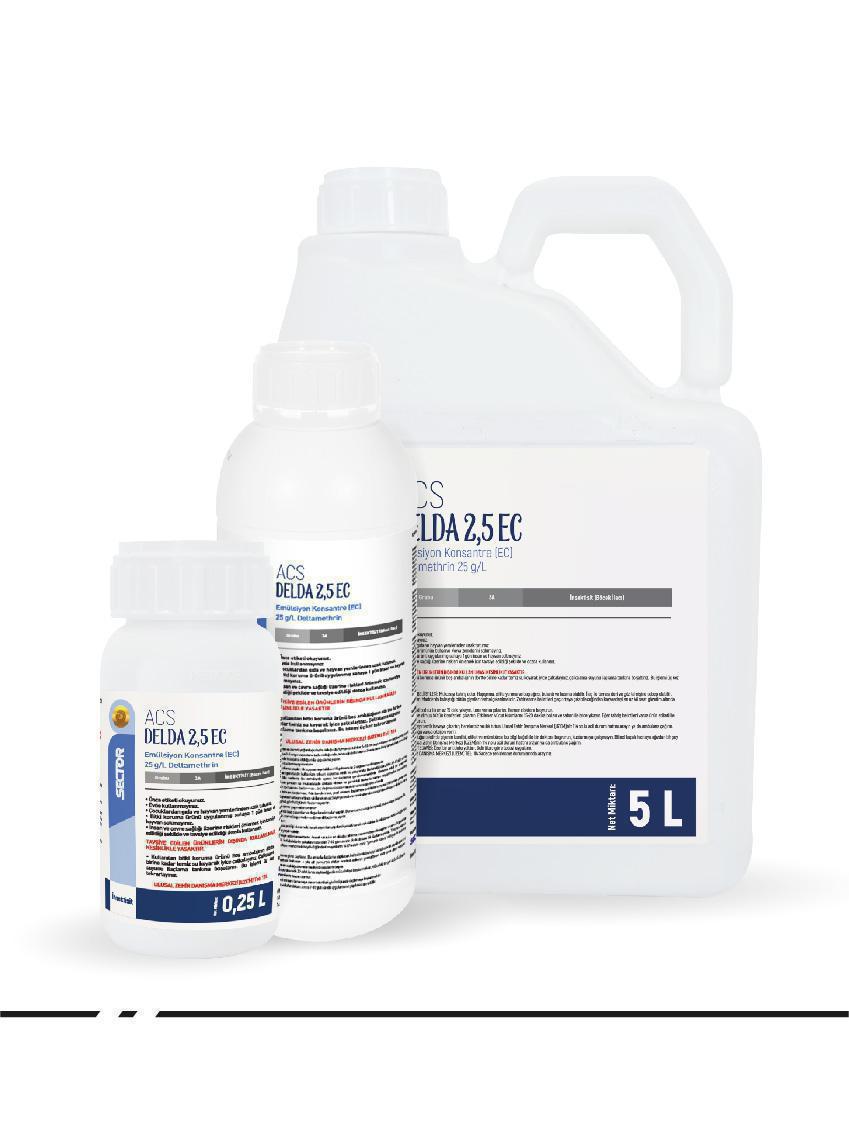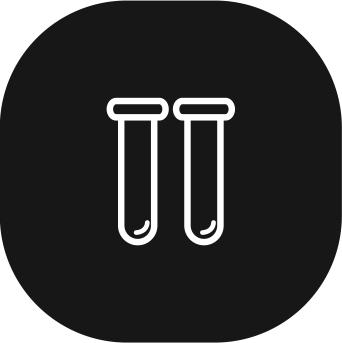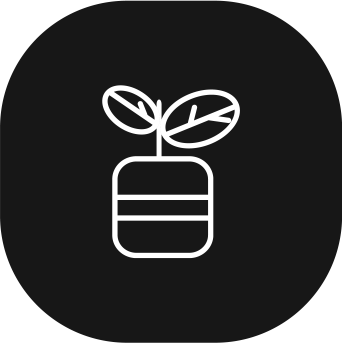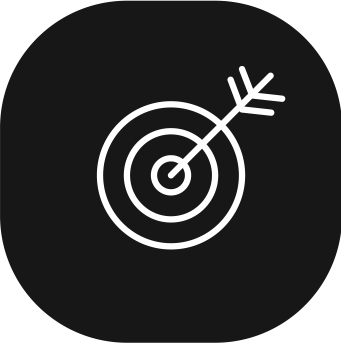
ACS Delda 2,5 EC
Category: Crop Protection
Product Group: Insecticide (Insecticide)
Active Agent: 25 g/L Deltamethrin
Formulation: Emulsion Concentrate (EC)
Eggplant and Zucchini-Silverleaf Whitefly The area where an infestation of silverleaf whitefly has been detected is entered in the direction of the diagonal lines. Every 5 steps, 50 leaves are collected from the bottom, middle and top leaves. Chemical control begins when there are 5 larvae-pupae per leaf. Bean Aphids: The field is entered in the direction of the diagonal lines from April, and every 3 to 5 steps, a leaf is randomly selected among the fresh leaves and shoots of the plants. As a result of counts made with magnifier on 25-50 leaves of legumes, 20-40 leaves of broad leaf plants such as eggplant, cucurbitaceae and cabbage; control is decided if the number of pests per leaf is 10-20. Tomato - Old World Bollworm: The field is entered in the direction of the diagonal lines and depending on the size of the field, 50 to 100 plants are checked, and eggs and larvae are looked for on the flowers, leaves, stems, fruits and shoots of the plants. When 5 out of 100 plants are infested, application is carried out. Codling Moth: The spraying of codling moth should be done according to the prediction and early warning system. The objective in codling moth control is to kill the hatched larvae before they enter the fruit by treating the trees with insecticides during the emergence of the larvae of each generation. Apple Ermine: It is sprayed when 4 groups of larvae have penetrated the epidermis or formed webs in a bouquet of 100 leaves to represent the garden. Vine Leafroller Tortrix: It should be applied 10 and 30 days after the first larvae emerge from the wintering grounds when they appear on the vine buds coming up in the spring. European Grapevine Moth: Application times for the European grapevine moth are determined according to the prediction-warning system. For the application of larvicide, the number of moths caught in the traps should peak and then decrease; in the first generation, the total effective temperature total should be 120 days-degrees, the twilight temperatures should be 15 0C and above for 2 consecutive days, and this should remain so in the following days. The total effective temperature should reach 520 days-degrees in the 2nd generation and 1047 days-degrees in the 3rd generation, the phenology of the vine should be flower bud in the 1st generation, unripe grape in the 2nd generation and beginning of sweetening in the 3rd generation. When the first larval emergence is seen, the application is decided. An application is made in each generation. Pear Psyllid: Spraying is carried out when all eggs laid by overwintering generation adults hatch, stage two and three nymphs begin to appear and more than 15% of the shoots are infested. Pistachio psyllid: If 20-30 nymphs per leaf are found in weekly counts on 100 combined leaves, spraying should be performed before most eggs hatch and before the first adult parasitoids appear and form a sticky layer (fumagine) on the leaf surface. Potato Beetle: When the average daily temperature reaches 14-15 0C, the field is entered in the direction of diagonal lines and eggs, larvae, and adults of the pest are searched in the seedbed. If any of them is found, this means that the field is contaminated. If the first generation is to be sprayed, it should be done when the first mature larvae (4th period) are seen on the plants. If the second generation is sprayed, egg hatching must be completed. Since the plant can tolerate damage due to insect density during this period, spraying may not be necessary. However, the research has shown that 20% of the damage caused by the potato beetle to the leaves of the potato plant can be tolerated by the plant and there is no decline in the product. Depending on the phenological period and development of the plant, this rate can be up to 40%. Lentil Sitona Weevil: In dry periods and high pest density, spraying is carried out once when the plants are 5-10 cm tall. Lentil Apion: For adult control, the application is carried out when there are an average of 3-5 adults or more per m2, when there are 3 or more flower buds with larvae per plant, or when more than 10% of terminal buds are infested. Lentil Psychid Moth: Spraying should be carried out in case of very heavy infestation. Stalk Borer: Application is made when the first egg is detected. After the first application, 2 more applications are performed at 15-day intervals. Sugar Beet Flea Beetle: Since the seed used in sugar beet growing areas is sprayed with a systemically active preparation, the plant is protected from infestation by the beet flea for 35-40 days. Therefore, spraying is not necessary in these areas. It is very important to proceed with caution when controlling beet flea beetles on areas where seeds are sown that are not sprayed with a systemically active preparation, and to start control without losing time if necessary. When spraying, it is necessary to spray the surface of the field completely, leaving no untouched areas. Sugar Beet - Cutworm: Chemical control methods are used against the pest, such as baiting, spraying seeds, dipping seedlings and spraying green parts. During the sowing and planting period, the field is entered in the direction of the diagonal lines, the undersides of the plants in a square meter area are checked in at least 5 different places, the larva of the pest is searched for, spraying is carried out when 2-3 larvae are seen per square meter. Sugar Beet - Tortoise Beetle: They are prevented from doing harm by being sprayed. Grains - Sunn Pest: After the appearance of the sunn pests in the fields, some counts and assessments are made in the fields. Asa result of this, chemical control is decided. Grain Weevil: Spraying is carried out 10 days after emergence from the soil (bolting period). Grain - Cereal Ground Beetle: Surface is sprayed. Olive Fruit Fly: If the number of adult olive fruit flies caught in the traps increases and a sufficient number of indentations is detected when counting the number of indentations during the period when the fruits reach maturity for egg laying, chemical control should be carried out. Olive Kernel Borer: Spraying is not recommended in the antophagous generation of the pest. However, if more than 10% damage to leaves and new shoots is observed at the beginning of the season in years with low harvest, spraying is carried out for the antophagous generation 7-10 days after the appearance of the first moths in the antophagous generation. Preferably, spraying should be carried out only for antophagous generation. Spraying is carried out when there are live “eggs + larvae” in 10% of the controlled lentil-sized fruits. Black Scale: The application period depends on the active appearance of the larvae. For this purpose, females with eggs belonging to that year are controlled on 20-25 cm shoots from 4 sides of the tree in a number representing the garden in the gardens to be sprayed, and the active larvae hatching from the eggs is determined. The first application is carried out during the period when 50% of the eggs are open, and the second application is carried out during the period when 90% of the eggs are open. Sunflower - Alfalfa Webworm: When 3-5 larvae are found on a plant or 20 larvae per square meter, control should begin. The control should be performed against the stage three larvae at the latest. Success is difficult in stage four and stage five. Sunflower - Old World Bollworm: Spraying should begin when eggs, stage one larvae or signs of harm are observed on 5 out of 100 plants. Cherry Fruit Fly: Application is necessary within 7-10 days after the first adult is caught in visual yellow sticky traps.
| Plant Name | Harmful Organism Name | Application dosage | Time Between Last Application and Harvest |
| Pumpkin | Silverleaf whitefly (Bemisia tabaci) | 100 ml/da | 3 days |
| Tomato | Old World Bollworm (Helicoverpa armigera) | 50 ml/da | 3 days |
| (greehouse) | (larvae) | ||
| Eggplant | Silverleaf whitefly (Bemisia tabaci) | 100 ml/da | 3 days |
| (field) | (larvae-pupae-adult) | ||
| Bean | Aphids (Aphis spp.) | 50 ml/da | 3 days |
| Apple | Codling Moth (Cydia pomonella) | 15 ml/100 L water | 3 days |
| Apple Ermine (Yponomeuta malinellus) | 5 ml/100 L water | ||
| Vineyard* | Vine Leafroller Tortrix (Spargonathis pilleriana) | 50 ml/100 L water | 3 days |
| European Grapevine Moth (Lobesia botrana) | 30 ml/100 L water | ||
| Pear | Pear Psyllid (Cacopsylla pyri) | 50 ml/100 L water | 3 days |
| Pistachio | Pistachio psyllid (Agonoscena pistaciae) | 30 ml/100 L water | 3 days |
| Potatoes | Potato beetle (Leptinotarsa decemlineata) | 30 ml/da | 3 days |
| Lentil, | Lentil Sitona Weevil (Sitona sp.) | 50 ml/da | |
| Chickpea | Lentil Apion (Apion arrogans) | 50 ml/da | 3 days |
| Old World Bollworm (Helicoverpa armigera) | 20 ml/da | ||
| Psychid Moth (Amicta oboberthuri) | 30 ml/da | ||
| Corn | Stalk Borer (Sesamia spp.) | 50 ml/da (3 applications at 15-day intervals) | 3 days |
| Sugar Beet | Sugar Beet Flea Beetle (Chatochnema spp.) | 25 ml/da | 3 days |
| Cutworm (Agrotis spp.) | |||
| Tortoise Beetle (Cassida spp.) | |||
| Grains | Sunn Pest (Eurygester sp) | 30 ml/da (stage 1-3 nymph) | 3 days |
| 50 ml/da; (nymphs of 4th to 5th stages, and new generation adult) | |||
| Grain Weevil (Pachytchius sp) | 30 ml/da | ||
| Cereal Ground Beetle (Zabrus spp) | 20 ml/da (surface application) | ||
| Olive | Olive Fruit Fly (Bactrocera oleae) | 25 ml/100 L water | 3 days |
| Olive Kernel Borer (Prays Oleae) | 30 ml/100 L water | ||
| Black Scale (Saissetia oleae) | 25 ml/100 L water | ||
| Sunflower | Alfalfa Webworm on Sunflower (Loxostege sticticalis) | 25 ml 100 L water | 3 days |
| Old World Bollworm (Helicoverpa armigera) | 75 ml 100 L water | ||
| Hazelnut | Gypsy Moth (Lymantria dispar) | 30 ml/100 L water | 3 days |
| Cherry | Cherry Fruit Fly (Rhagoletis cerasi) | 25 ml 100 L water (adult) | 3 days |


 Türkçe
Türkçe  English
English  Russian
Russian  Arabic
Arabic  Germany
Germany  French
French  Spanish
Spanish 








